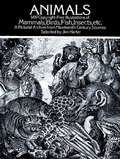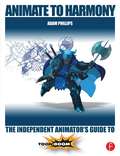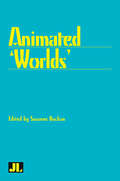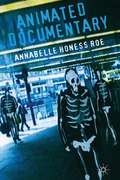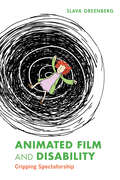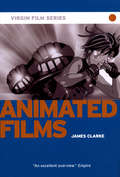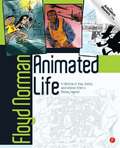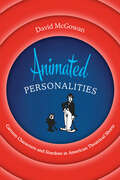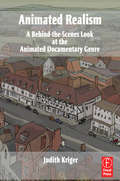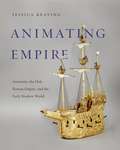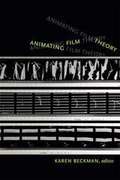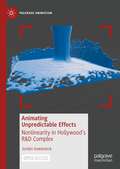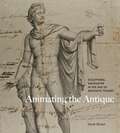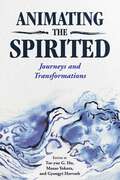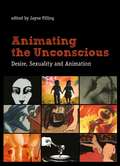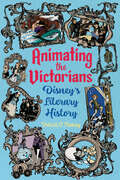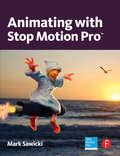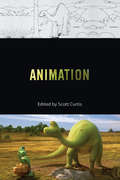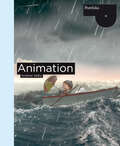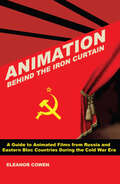- Table View
- List View
Animals: 1,419 Copyright-Free Illustrations of Mammals, Birds, Fish, Insects, etc (Dover Pictorial Archive)
by Jim HarterSelected for its visual impact and ease of use, this outstanding collection of wood engravings presents over 1,000 species of animals in extremely lifelike poses. Includes many different versions of familiar mammals, birds, reptiles, amphibians, fish, insects, and other invertebrates such as spiders, crabs, squid, earthworms, and more. Captions provide modern common-name identifications.
Animate to Harmony: The Independent Animator's Guide to Toon Boom
by Adam PhillipsWant to create studio-quality work and get noticed? Just coming off Flash and looking for a Toon Boom intro? Are you a traditional pencil-and-paper animator? From scene setup to the final render, learn how to navigate the Toon Boom interface to create animation that can be published on a variety of platforms and formats. Animate to Harmony guides you through Toon Boom’s Animate, Animate Pro and Harmony programs, teaching you how to create high-quality 2D animation of all complexities. The main text focuses onfeatures that are common across all three programs while "Advanced Techniques" boxes throughout the book elaborate on Pro and Harmony features, appealing to all levels of experience with any of the three main Toon Boom products.
Animated 'Worlds'
by Suzanne BuchanWhat do we mean by the term "animation" when we are discussing film? Is it a technique? A style? A way of seeing or experiencing "a world" that has little relation to our own lived experience of "the world"? In Animated Worlds, contributors reveal the astonishing variety of "worlds" animation confronts us with. Essays range from close film analyses to phenomenological and cognitive approaches, spectatorship, performance, literary theory, and digital aesthetics. Authors include Vivian Sobchack, Richard Weihe, Thomas Lamarre, Paul Wells, and Karin Wehn.
Animated Documentary
by Annabelle Honess RoeAnimated Documentary, the first book to be published on this fascinating topic, considers how animation is used as a representational strategy in nonfiction film and television and explores the ways animation expands the range and depth of what documentary can show us about the world. On behalf of the Society for Animation Studies(SAS), the Chair of the Jury announced the book as the winner of the delayed 2015 SAS McLaren-Lambart Award with the following words: 'Animated Documentary is a vital addition to both animation scholarship and film studies scholarship more broadly, expertly achieving the tricky challenge of synthesising these two scholarly traditions to provide a compelling and brilliantly coherent account of the animated documentary form. At the heart of Roe's book is the conviction that animated documentary "has the capacity to represent temporally, geographically, and psychologically distal aspects of life beyond the reach of live action" (p. 22). As a representational strategy, Roe details how animated documentary can be seen to adopt techniques of "mimetic substitution, non-mimetic substitution and evocation" in response to the limitations of live action material (p. 26). Animated Documentary will without doubt become an essential resource for many years to come for anyone interested in the intersection of animation and documentary. '
Animated Film and Disability: Cripping Spectatorship
by Slava GreenbergWhile many live-action films portray disability as a spectacle, "crip animation" (a genre of animated films that celebrates disabled people's lived experiences) uses a variety of techniques like clay animation, puppets, pixilation, and computer-generated animation to represent the inner worlds of people with disabilities. Crip animation has the potential to challenge the ableist gaze and immerse viewers in an alternative bodily experience.In Animated Film and Disability, Slava Greenberg analyzes over 30 animated works about disabilities, including Rocks in My Pockets, An Eyeful of Sound, and A Shift in Perception. He considers the ableism of live-action cinematography, the involvement of filmmakers with disabilities in the production process, and the evocation of the spectators' senses of sight and hearing, consequently subverting traditional spectatorship and listenership hierarchies. In addition, Greenberg explores physical and sensory accessibility in theaters and suggests new ways to accommodate cinematic screenings.Offering an introduction to disability studies and crip theory for film, media, and animation scholars, Animated Film and Disability demonstrates that crip animation has the power to breach the spectator's comfort, evoking awareness of their own bodies and, in certain cases, their social privileges.
Animated Films - Virgin Film
by James ClarkeAnimation has never been so popular. The best animated films have combined the latest technology with creativity and a flair for storytelling and are adored by both children and adults. With films such as Monsters, Inc., Shrek and Toy Story capturing the imagination of moviegoers and critics, animated film is enjoying a resurgence unseen since its golden age in the 30s and 40s. From the earliest full-length feature animation, Disney's Snow White and the Seven Dwarfs, through stop-motion animation and Japanese anime to the advent of CGI, this book takes a critical look at animation through the ages and explores its infinite cinematic possibilities.
Animated Life: A Lifetime of tips, tricks, techniques and stories from a Disney Legend
by Floyd NormanA well designed, well written animated film has warmth, humor and charm. Since Steamboat Mickey, animators have been creating characters and films that are charming, warm and humorous, allowing people to connect with the animated medium. Animaton fans love the characters for a lifetime. This is the legacy of the countless animators and artists who created the classic characters and fun stories and the legacy of Disney Legend, Floyd Norman. Written with wit and verve, Animated Life is a guided tour through an entire lifetime of techniques, practical hands-on advice and insight into an entire industry. A vital tutorial in animation's past, present and future for students who are now poised to be part of another new generation in the art form. Apply artistic magic to your own projects and garner valuable insight and inspiration from a True Disney legend. With valuable advice, critical comment, and inspiration for every student of the arts, Animated Life is a classic in the making with completely relevant techniques and tools for the contemporary animation or fine arts professional.
Animated Origami Faces
by Joel SternBlending the art of paperfolding with the magic of animation, this fun and fascinating book will help origami enthusiasts at every skill level create twelve delightful faces filled with movement and life. Using ordinary letter-size paper, anyone can make lively three-dimensional faces with blinking eyes, snapping jaws, and wiggling ears:* Talking Bird* Masked Super Hero* Blowfish* Elephant* Dog* Monkey ...and more!With this simple method of paperfolding, no tools or glues are required. Just follow the easy step-by-step diagrams, accompanied by tons of helpful tips on technique, and crystal clear illustrations. An inspiring way to create homemade masks, this unique guide also includes suggestions for creating your own movable models, letting crafters mix and match features to invent new and unusual origami species!
Animated Personalities: Cartoon Characters and Stardom in American Theatrical Shorts
by David McGowanMickey Mouse, Betty Boop, Donald Duck, Bugs Bunny, Felix the Cat, and other beloved cartoon characters have entertained media audiences for almost a century, outliving the human stars who were once their contemporaries in studio-era Hollywood. In Animated Personalities, David McGowan asserts that iconic American theatrical short cartoon characters should be legitimately regarded as stars, equal to their live-action counterparts, not only because they have enjoyed long careers, but also because their star personas have been created and marketed in ways also used for cinematic celebrities.Drawing on detailed archival research, McGowan analyzes how Hollywood studios constructed and manipulated the star personas of the animated characters they owned. He shows how cartoon actors frequently kept pace with their human counterparts, granting “interviews,” allowing “candid” photographs, endorsing products, and generally behaving as actual actors did—for example, Donald Duck served his country during World War II, and Mickey Mouse was even embroiled in scandal. Challenging the notion that studios needed actors with physical bodies and real off-screen lives to create stars, McGowan demonstrates that media texts have successfully articulated an off-screen existence for animated characters. Following cartoon stars from silent movies to contemporary film and television, this groundbreaking book broadens the scope of star studies to include animation, concluding with provocative questions about the nature of stardom in an age of digitally enhanced filmmaking technologies.
Animated Personalities: Cartoon Characters and Stardom in American Theatrical Shorts
by David McGowanThis pioneering book makes the case that iconic cartoon characters, such as Mickey Mouse, are legitimate cinematic stars, just as popular human actors are.Mickey Mouse, Betty Boop, Donald Duck, Bugs Bunny, Felix the Cat, and other beloved cartoon characters have entertained media audiences for almost a century, outliving the human stars who were once their contemporaries in studio-era Hollywood. In Animated Personalities, David McGowan asserts that iconic American theatrical short cartoon characters should be legitimately regarded as stars, equal to their live-action counterparts, not only because they have enjoyed long careers, but also because their star personas have been created and marketed in ways also used for cinematic celebrities.Drawing on detailed archival research, McGowan analyzes how Hollywood studios constructed and manipulated the star personas of the animated characters they owned. He shows how cartoon actors frequently kept pace with their human counterparts, granting &“interviews,&” allowing &“candid&” photographs, endorsing products, and generally behaving as actual actors did—for example, Donald Duck served his country during World War II, and Mickey Mouse was even embroiled in scandal. Challenging the notion that studios needed actors with physical bodies and real off-screen lives to create stars, McGowan demonstrates that media texts have successfully articulated an off-screen existence for animated characters. Following cartoon stars from silent movies to contemporary film and television, this groundbreaking book broadens the scope of star studies to include animation, concluding with provocative questions about the nature of stardom in an age of digitally enhanced filmmaking technologies.&“[Animated Personalities] is impressive for its lucid historical structure and exceptionally enjoyable content . . . McGowan breathes life into celluloid figures, giving readers a backstory for some of the most enduring iconic characters of screen history. This is a truly gratifying book.&” —Choice&“Combining historical, formal, and theoretical modes of analysis, Animated Personalities represents a vital contribution to both star studies and the study of animation in classical Hollywood and beyond. By embracing a key problematic of the study of stardom―the inability to take any element of its construction as authentic―McGowan does not undermine the validity of this approach so much as craft a more honest and complete understanding of it.&” —Synoptique
Animated Realism: A Behind The Scenes Look at the Animation Tools and Techniques of Award Winning Films
by Judith KrigerWith the development and accessibility of animation tools and techniques, filmmakers are blurring the boundaries between documentary filmmaking and animation. The intimacy, imperfection and charm of the animated form is providing live-action and animation directors with unique ways to tell stories, humanize events and convey information not easily adapted for live-action media. "Animated Realism" presents animation techniques as they apply to the documentary genre with an inspirational behind-the-scenes look at award-winning animated documentaries. Animators and documentary filmmakers alike will learn how to develop a visual style with animation, translate a graphic novel into a documentary and use 3D animation as a storytelling tool, all in the context of creating animated documentaries. With insight and inspiration, "Animated Realism" includes interviews from industry luminaries like John Canemaker, Oscar Winning Director of "The Moon and the Son", Yoni Goodman, Animation Director of Oscar Nominated Waltz with Bashir and Chris Landreth, Oscan Winning creator of Ryan. Packed with beautiful, instructive illustrations and previously unpublished material (including storyboards, photos and hand-drawn sketches) and interspersed with interviews - this is an exceptional source of inspiration and knowledge for animators, students and fans alike. With a companion website featuring animated shorts from leading animated documentaries, animators, students and documentary filmmakers will be able to analyze and apply Oscar-winning animation techniques to their own films. Learn from the best...Judith Kriger interviews some of the most innovative and inspirational animators, including John Canemaker, Oscar Winning Director of "The Moon and the Son", Yoni Goodman, Animation Director of Oscar Nominated Waltz with Bashir and Chris Landreth, Oscan Winning Director of Ryan.
Animating Empire: Automata, the Holy Roman Empire, and the Early Modern World
by Jessica KeatingIn the sixteenth and seventeenth centuries, German clockwork automata were collected, displayed, and given as gifts throughout the Holy Roman, Ottoman, and Mughal Empires. In Animating Empire, Jessica Keating recounts the lost history of six such objects and reveals the religious, social, and political meaning they held.The intricate gilt, silver, enameled, and bejeweled clockwork automata, almost exclusively crafted in the city of Augsburg, represented a variety of subjects in motion, from religious figures to animals. Their movements were driven by gears, wheels, and springs painstakingly assembled by clockmakers. Typically wound up and activated by someone in a position of power, these objects and the theological and political arguments they made were highly valued by German-speaking nobility. They were often given as gifts and as tribute payment, and they played remarkable roles in the Holy Roman Empire, particularly with regard to courtly notions about the important early modern issues of universal Christian monarchy, the Reformation, the Counter-Reformation, the encroachment of the Ottoman Empire, and global trade.Demonstrating how automata produced in the Holy Roman Empire spoke to a convergence of historical, religious, and political circumstances, Animating Empire is a fascinating analysis of the animation of inanimate matter in the early modern period. It will appeal especially to art historians and historians of early modern Europe.E-book editions have been made possible through support of the Art History Publication Initiative (AHPI), a collaborative grant from the Andrew W. Mellon Foundation.
Animating Empire: Automata, the Holy Roman Empire, and the Early Modern World
by Jessica KeatingIn the sixteenth and seventeenth centuries, German clockwork automata were collected, displayed, and given as gifts throughout the Holy Roman, Ottoman, and Mughal Empires. In Animating Empire, Jessica Keating recounts the lost history of six such objects and reveals the religious, social, and political meaning they held.The intricate gilt, silver, enameled, and bejeweled clockwork automata, almost exclusively crafted in the city of Augsburg, represented a variety of subjects in motion, from religious figures to animals. Their movements were driven by gears, wheels, and springs painstakingly assembled by clockmakers. Typically wound up and activated by someone in a position of power, these objects and the theological and political arguments they made were highly valued by German-speaking nobility. They were often given as gifts and as tribute payment, and they played remarkable roles in the Holy Roman Empire, particularly with regard to courtly notions about the important early modern issues of universal Christian monarchy, the Reformation, the Counter-Reformation, the encroachment of the Ottoman Empire, and global trade.Demonstrating how automata produced in the Holy Roman Empire spoke to a convergence of historical, religious, and political circumstances, Animating Empire is a fascinating analysis of the animation of inanimate matter in the early modern period. It will appeal especially to art historians and historians of early modern Europe.E-book editions have been made possible through support of the Art History Publication Initiative (AHPI), a collaborative grant from the Andrew W. Mellon Foundation.
Animating Film Theory
by Karen BeckmanAnimating Film Theory provides an enriched understanding of the relationship between two of the most unwieldy and unstable organizing concepts in cinema and media studies: animation and film theory. For the most part, animation has been excluded from the purview of film theory. The contributors to this collection consider the reasons for this marginalization while also bringing attention to key historical contributions across a wide range of animation practices, geographic and linguistic terrains, and historical periods. They delve deep into questions of how animation might best be understood, as well as how it relates to concepts such as the still, the moving image, the frame, animism, and utopia. The contributors take on the kinds of theoretical questions that have remained underexplored because, as Karen Beckman argues, scholars of cinema and media studies have allowed themselves to be constrained by too narrow a sense of what cinema is. This collection reanimates and expands film studies by taking the concept of animation seriously.Contributors. Karen Beckman, Suzanne Buchan, Scott Bukatman, Alan Cholodenko, Yuriko Furuhata, Alexander R. Galloway, Oliver Gaycken, Bishnupriya Ghosh, Tom Gunning, Andrew R. Johnston, Hervé Joubert-Laurencin, Gertrud Koch, Thomas LaMarre, Christopher P. Lehman, Esther Leslie, John MacKay, Mihaela Mihailova, Marc Steinberg, Tess Takahashi
Animating Unpredictable Effects: Nonlinearity in Hollywood’s R&D Complex (Palgrave Animation)
by Jordan GowanlockUncanny computer-generated animations of splashing waves, billowing smoke clouds, and characters’ flowing hair have become a ubiquitous presence on screens of all types since the 1980s. This Open Access book charts the history of these digital moving images and the software tools that make them. Unpredictable Visual Effects uncovers an institutional and industrial history that saw media industries conducting more private R&D as Cold War federal funding began to wane in the late 1980s. In this context studios and media software companies took concepts used for studying and managing unpredictable systems like markets, weather, and fluids and turned them into tools for animation. Unpredictable Visual Effects theorizes how these animations are part of a paradigm of control evident across society, while at the same time exploring what they can teach us about the relationship between making and knowing.
Animating the Antique: Sculptural Encounter in the Age of Aesthetic Theory
by Sarah BetzerFramed by tensions between figural sculpture experienced in the round and its translation into two-dimensional representations, Animating the Antique explores enthralling episodes in a history of artistic and aesthetic encounters. Moving across varied locations—among them Rome, Florence, Naples, London, Dresden, and Paris—Sarah Betzer explores a history that has yet to be written: that of the Janus-faced nature of interactions with the antique by which sculptures and beholders alike were caught between the promise of animation and the threat of mortification.Examining the traces of affective and transformative sculptural encounters, the book takes off from the decades marked by the archaeological, art-historical, and art-philosophical developments of the mid-eighteenth century and culminantes in fin de siècle anthropological, psychological, and empathic frameworks. It turns on two fundamental and interconnected arguments: that an eighteenth-century ontology of ancient sculpture continued to inform encounters with the antique well into the nineteenth century, and that by attending to the enduring power of this model, we can newly appreciate the distinctively modern terms of antique sculpture’s allure. As Betzer shows, these eighteenth-century developments had far-reaching ramifications for the making and beholding of modern art, the articulations of art theory, the writing of art history, and a significantly queer Nachleben of the antique.Bold and wide-ranging, Animating the Antique sheds light upon the work of myriad artists, in addition to that of writers ranging from Goethe and Winckelmann to Hegel, Walter Pater, and Vernon Lee. It will be especially welcomed by scholars and students working in eighteenth- and nineteenth-century art history, art writing, and art historiography.
Animating the Spirited: Journeys and Transformations
by Tze-yue G. Hu, Masao Yokota and Gyongyi HorvathContributions by Graham Barton, Raz Greenberg, Gyongyi Horvath, Birgitta Hosea, Tze-yue G. Hu, Yin Ker, M. Javad Khajavi, Richard J. Leskosky, Yuk Lan Ng, Giryung Park, Eileen Anastasia Reynolds, Akiko Sugawa-Shimada, Koji Yamamura, Masao Yokota, and Millie Young Getting in touch with a spiritual side is a craving many are unable to express or voice, but readers and viewers seek out this desired connection to something greater through animation, cinema, anime, and art. Animating the Spirited: Journeys and Transformations includes a range of explorations of the meanings of the spirited and spiritual in the diverse, dynamic, and polarized creative environment of the twenty-first century. While animation is at the heart of the book, such related subjects as fine art, comics, children's literature, folklore, religion, and philosophy enrich the discoveries. These interdisciplinary discussions range from theory to practice, within the framework of an ever-changing media landscape. Working on different continents and coming from varying cultural backgrounds, these diverse scholars, artists, curators, and educators demonstrate the insights of the spirited. Authors also size up new dimensions of mental health and related expressions of human living and interactions. While the book recognizes and acknowledges the particularities of the spirited across cultures, it also highlights its universality, demonstrating how it is being studied, researched, comprehended, expressed, and consumed in various parts of the world.
Animating the Unconscious: Desire, Sexuality and Animation
by Jayne PillingDetailed analysis of both the process and practice of key contemporary filmmakers, while also raising more general issues around the specificities of animation.
Animating the Unconscious: Desire, Sexuality, and Animation
by Ed. Jayne PillingAs critical interest has grown in the unique ways in which art animation explores and depicts subjective experience – particularly in relation to desire, sexuality, social constructions of gender, confessional modes, fantasy, and the animated documentary – this volume offers detailed analysis of both the process and practice of key contemporary filmmakers, while also raising more general issues around the specificities of animation. Combining critical essays with interview material, visual mapping of the creative process, consideration of the neglected issue of how the use of sound differs from that of conventional live-action, and filmmakers' critiques of each others' work, this unique collection aims to both provoke and illuminate via an insightful multi-faceted approach.
Animating the Victorians: Disney's Literary History (Children's Literature Association Series)
by Patrick C. FlemingMany Disney films adapt works from the Victorian period, which is often called the Golden Age of children’s literature. Animating the Victorians: Disney’s Literary History explores Disney’s adaptations of Victorian texts like Alice in Wonderland, Oliver Twist, Treasure Island, Peter Pan, and the tales of Hans Christian Andersen. Author Patrick C. Fleming traces those adaptations from initial concept to theatrical release and beyond to the sequels, consumer products, and theme park attractions that make up a Disney franchise. During the production process, which often extended over decades, Disney’s writers engaged not just with the texts themselves but with the contexts in which they were written, their authors’ biographies, and intervening adaptations. To reveal that process, Fleming draws on preproduction reports, press releases, and unfinished drafts, including materials in the Walt Disney Company Archives, some of which have not yet been discussed in print. But the relationship between Disney and the Victorians goes beyond adaptations. Walt Disney himself had a similar career to the Victorian author-entrepreneur Charles Dickens. Linking the Disney Princess franchise to Victorian ideologies shows how gender and sexuality are constantly being renegotiated. Disney’s animated musicals, theme parks, copyright practices, and even marketing campaigns depend on cultural assumptions, legal frameworks, and media technologies that emerged in nineteenth-century England. Moreover, Disney’s adaptations influence modern students and scholars of the Victorian period. By applying scholarship in Victorian studies to a global company, Fleming shows how institutions mediate our understanding of the past and demonstrates the continued relevance of literary studies in a corporate media age.
Animating with Stop Motion Pro
by Mark SawickiAnimating with Stop Motion Pro is comprehensive, hands-on guide to achieving professional results with Stop Motion Pro 7.0 software. Gone are the days of stop motion guesswork and waiting to see the finalized result of your meticulous, labor intensive animations. With the push of a mouse button and the Stop Motion Pro software, animators have ten times the capability of simple camera stop motion capture. Re-visualize stop motion character movements, graph these movements and composite characters into a flawless animations with the techniques and step by step tutorials featured in Animating with Stop Motion Pro. Detailed exercises allow you to develop professional animations with the included free trial of Stop Motion Pro 7.0.
Animation (Behind the Silver Screen Series)
by Andrew Johnston Susan Ohmer Bob Rehak Kevin Sandler Alla GadassikFrom the earliest motion pictures and cartoons of the 1900s, to the latest 3D animated feature and CGI blockbuster, animation has always been a part of the cinematic experience. While the boundaries between animation and live-action have often been carefully tended, the ubiquity of contemporary computer imaging certainly blurs those lines, thereby confirming the importance of animation for the history of American cinema. The last installment of the acclaimed Behind the Silver Screen series, Animation explores the variety of technologies and modes of production throughout the history of American animation: the artisanal, solitary labors of early animators such as Winsor McCay, or of independent animators such as Mary Ellen Bute; the industrial assembly lines of Hollywood studio-unit animation; the parsimonious production houses of the post-studio, post-war era; the collaborative approach of boutique animation and special-effect houses. Drawing on archival sources, this volume provides not only an overview of American animation history, but also, by focusing on the relationship between production and style, a unique approach to understanding animation in general.
Animation (Portfolio Ser.)
by Andrew SelbyFrom scriptwriting through to production, this introduction to animation for students surveys key technical processes and examines a variety of stylistic approaches. The book includes visual examples from key animators and illustrated features on how to create exciting animation for a variety of audiences.It begins with history and context, and quickly moves on to more practical aspects of the craft. Box features outline practical information and visual examples of different animators’ work and working processes teach how to create exciting animation for any audience. A final chapter on job roles shows how students can get on in animation.This book is a vital resource for anyone who intends to make animation a part of their career.
Animation (Portfolio)
by Andrew SelbyFrom scriptwriting through to production, this introduction to animation for students surveys key technical processes and examines a variety of stylistic approaches. The book includes visual examples from key animators and illustrated features on how to create exciting animation for a variety of audiences.It begins with history and context, and quickly moves on to more practical aspects of the craft. Box features outline practical information and visual examples of different animators’ work and working processes teach how to create exciting animation for any audience. A final chapter on job roles shows how students can get on in animation.This book is a vital resource for anyone who intends to make animation a part of their career.
Animation Behind the Iron Curtain
by Eleanor CowenAnimation Behind the Iron Curtain is a journey of discovery into the world of Soviet era animation from Eastern Bloc countries. From Jerzy Kucia's brutally exquisite Reflections in Poland to the sci-fi adventure of Ott in Space by Estonian puppet master Elbert Tuganov to the endearing Gopo's little man by Ion Popescu-Gopo in Romania, this excursion into Soviet era animation brings to light magnificent art, ruminations on the human condition, and celebrations of innocence and joy.As art reveals the spirit of the times, animation art of Eastern Europe during the Cold War, funded by the Soviet states, allowed artists to create works illuminating to their experiences, hopes, and fears. The political ideology of the time ironically supported these artists while simultaneously suppressing more direct critiques of Soviet life. Politics shaped the world of these artists who then fashioned their realities into amazing works of animation. Their art is integral to the circumstances in which they lived, which is why this book combines the unlikely combination of world politics and animated cartoons.The phenomenal animated films shared in this book offer a glimpse into the culture and hearts of Soviet citizens who grew up with characters as familiar and beloved to them as Mickey Mouse and Bugs Bunny are to Americans. This book lays out the basic political dynamics of the Cold War and how those political tensions affected the animation industry in both the US and in the Eastern Bloc. And, for animation novices and enthusiasts alike, Animation Behind the Iron Curtain also offers breakout sections to explain many of the techniques and aesthetic considerations that go into this fascinating art form. This book is a must read for anyone interested in the Cold War era and really cool animated films!
